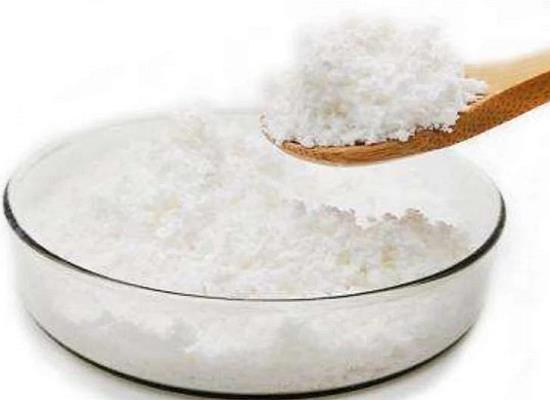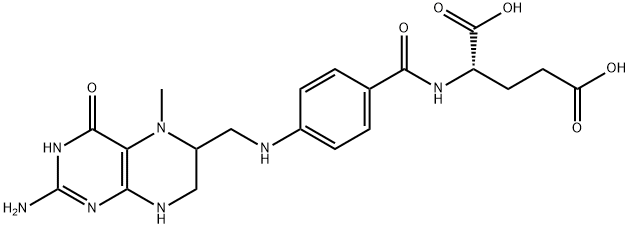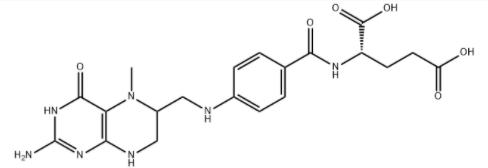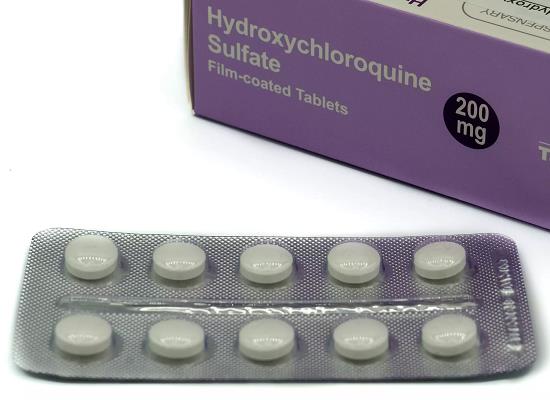5-Methyltetrahydrofolic acid: pharmacokinetics and physiological actions
General Description
5-Methyltetrahydrofolic acid is a form of folate that is efficiently absorbed in the proximal small intestine through the proton coupled folate transporter. It is metabolized from dietary folates and folic acid to 5-Methyltetrahydrofolic acid before being released into the circulation. 5-Methyltetrahydrofolic acid is distributed in the body through various mechanisms, including transport by specific plasma transporters. Once inside cells, it undergoes metabolic conversions to polyglutamate forms for tissue retention. 5-Methyltetrahydrofolic acid plays a crucial role in folate metabolism, serving as a transport form for various intracellular metabolic processes. It is important for DNA and RNA synthesis, as well as the synthesis of methionine from homocysteine. 5-Methyltetrahydrofolic acid has a slow turnover in the body and is primarily excreted in urine and feces. Its availability is measured by plasma and red blood cell folate concentrations, which are indicators of folate status. Adequate intake of 5-Methyltetrahydrofolic acid or folic acid helps regulate homocysteine levels and improve folate status in the body.

Figure 1. 5-Methyltetrahydrofolic acid
Pharmacokinetics
Absorption
5-Methyltetrahydrofolic acid, a form of folate, is absorbed in the proximal small intestine through the proton coupled folate transporter (PCFT). This transporter efficiently transports both oxidized and reduced forms of folates. During the passage across the intestinal mucosa, most dietary folates and folic acid are metabolized to 5-Methyltetrahydrofolic acid. Folic acid is converted to dihydrofolate (DHF) and then to tetrahydrofolate (THF) by enzymes in the mucosal cell, and further metabolized to 5-Methyltetrahydrofolic acid via specific enzymes. Some of this conversion may occur in the liver before 5-Methyltetrahydrofolic acid is released into the circulation. At high intakes, unmetabolized folic acid and reduced folates can be detected in the bloodstream. Studies have shown that the bioavailability of 5-Methyltetrahydrofolic acid is at least as high as that of folic acid in humans. Single-dose studies using high doses may not accurately reflect the absorption of lower doses. Long-term studies indicate that 5-Methyltetrahydrofolic acid supplementation increases serum folate concentrations, with comparable increases in red blood cell folate levels between 5-Methyltetrahydrofolic acid and folic acid groups. These findings suggest that 5-Methyltetrahydrofolic acid is well-absorbed and bioavailable, making it a suitable alternative to folic acid supplementation. 1
Distribution
5-Methyltetrahydrofolic acid, a reduced form of folate, is distributed in the body through various mechanisms. It circulates either freely or loosely bound to plasma proteins. The primary transporter for 5-Methyltetrahydrofolic acid and other reduced folates in plasma is the reduced folate carrier-1 (RFC). RFC has a high specificity for reduced folates and a poor affinity for folic acid. Some tissues, like the liver, may utilize the proton-coupled folate transporter (PCFT) for transport. Another folate transporter called folate binding protein or folate receptor is expressed in limited tissues and exhibits high affinity for 5-Methyltetrahydrofolic acid and folic acid. Once inside cells, folate monoglutamate is converted to polyglutamate forms by the enzyme folylpolyglutamate synthetase (FPGS). 5-Methyltetrahydrofolic acid, the main form of folate, requires conversion to tetrahydrofolate (THF) via methionine synthase before effective polyglutamylation and tissue retention occur. Folic acid also undergoes similar metabolic steps. Homeostatic mechanisms regulate the demethylation of 5-Methyltetrahydrofolic acid, preventing excessive accumulation of folate in tissues when plasma folate levels are high. In summary, 5-Methyltetrahydrofolic acid is transported in its free or bound form through specific transporters in plasma and various tissues. Metabolic conversions are necessary for polyglutamylation and tissue retention, ensuring proper regulation of folate levels in the body. 2
Metabolism
5-Methyltetrahydrofolic acid is an important form of folate in human metabolism. Folate is a family of compounds based on the folic acid structure. Initially, folic acid lacks coenzyme activity until it is reduced to the active THF form. This reduction occurs in a two-step process via DHF, catalyzed by DHFR. 5-Methyltetrahydrofolic acid is the predominant form of folate entering human metabolism and serves as the transport form of folate in plasma. Folate coenzymes play specific roles in intracellular metabolism, including the synthesis of thymidylate and purines for DNA and RNA synthesis, and the synthesis of methionine from homocysteine. 5,10-methylene-THF plays a central role in these metabolic cycles. Serine is a major provider of one-carbon units for folate-dependent metabolism. Folate is also required for the synthesis of thymidylate, where the transfer of the one-carbon group from 5,10-methylene-THF generates deoxythymidine monophosphate. The methylation of homocysteine to produce methionine is catalyzed by methionine synthase using 5-Methyltetrahydrofolic acid as the methyl donor. Inadequate folate status can lead to increased plasma homocysteine levels, indicating folate insufficiency. 3
Elimination
Under normal conditions, 5-Methyltetrahydrofolic acid turnover in the body is slow, with a half-life of over 100 days. Only a small amount of intact folate is excreted in urine. The majority of tissue folate exists in the polyglutamate form. The catabolism process is not well understood but involves cleavage at the C9-N10 bond, generating p-amino-benzoylpolyglutamates and a pterin moiety. The p-amino-benzoylpolyglutamates are hydrolyzed to monoglutamate and excreted in urine. The pterin moiety is excreted in bile and appears in feces. Some 5-Methyltetrahydrofolic acid is secreted in bile but is largely reabsorbed in the intestine at low intakes. The proportion of 5-Methyltetrahydrofolic acid excreted in urine increases with higher plasma concentrations above 45 nmol/L. 4
Physiological actions
5-Methyltetrahydrofolic acid plays a crucial role in folate metabolism and homocysteine regulation in the human body. Plasma folate concentrations are used to measure immediate folate intake and bioavailability, while red blood cell (RBC) folate concentrations indicate long-term folate status. Low availability of 5-Methyltetrahydrofolic acid leads to increased plasma homocysteine concentrations, as the methyl group required for converting homocysteine to methionine is insufficient. Therefore, plasma homocysteine levels serve as a sensitive functional indicator of folate status. Studies have shown that increased intake of fruits and vegetables, rich sources of 5-Methyltetrahydrofolic acid, leads to higher plasma folate concentrations and lower homocysteine concentrations. Similar effects are observed with breakfast cereals, vitamin supplements (containing folic acid), and dietary folate from fruits and vegetables. Equimolar doses of 5-Methyltetrahydrofolic acid and folic acid have been found to be equally effective in increasing plasma and RBC folate concentrations and reducing plasma homocysteine concentration. These findings have been demonstrated in various controlled human dietary studies. Furthermore, randomized, double-blind, placebo-controlled studies have shown that the increase in plasma and RBC folate concentrations did not significantly differ between folic acid and 5-Methyltetrahydrofolic acid groups after 24 weeks of intake. Both forms were equally effective in lowering homocysteine concentrations. Therefore, 5-Methyltetrahydrofolic acid is considered at least as effective as folic acid in improving folate status and regulating homocysteine levels in the body. 4
Reference
1. Stern LL, Bagley PJ, Rosenberg IH, et al Conversion of 5-formyltetrahydrofolic acid to 5-methyltetrahydrofolic acid is unimpaired in folate adequate persons homozygous for the C677T mutation in the methylenetetrahydrofolate reductase gene. J Nutr 2000; 130 (9): 2238-2242.
2. Zhao R, Matherly LH, Goldman ID. Membrane transporters and folate homeostasis: intestinal absorption and transport into systemic compartments and tissues. Expert Rev Mol Med 2009; 11: e4.
3. Ferrazzi E, Tiso G, Di Martino D. Folic acid versus 5- methyl tetrahydrofolate supplementation in pregnancy. Eur J Obstet Gynecol Reprod Biol. 2020 Oct;253:312-319.
4. Gregory III JF, Williamson J, Liao JF, et al Kinetic model of folate metabolism in nonpregnant women consuming [2H2]folic acid: isotopic labeling of urinary folate and the catabolite para-acetamidobenzoylglutamate indicates slow, intake-dependent, turnover of folate pools. J Nutr 1998; 128 (11): 1896-1906.
You may like
Related articles And Qustion
Lastest Price from 5-Methyltetrahydrofolic acid manufacturers

US $10.00/ASSAYS2025-08-29
- CAS:
- 134-35-0
- Min. Order:
- 1ASSAYS
- Purity:
- 99%
- Supply Ability:
- 1 ton

US $10.00/KG2025-04-21
- CAS:
- 134-35-0
- Min. Order:
- 100KG
- Purity:
- 99%
- Supply Ability:
- 100 mt



